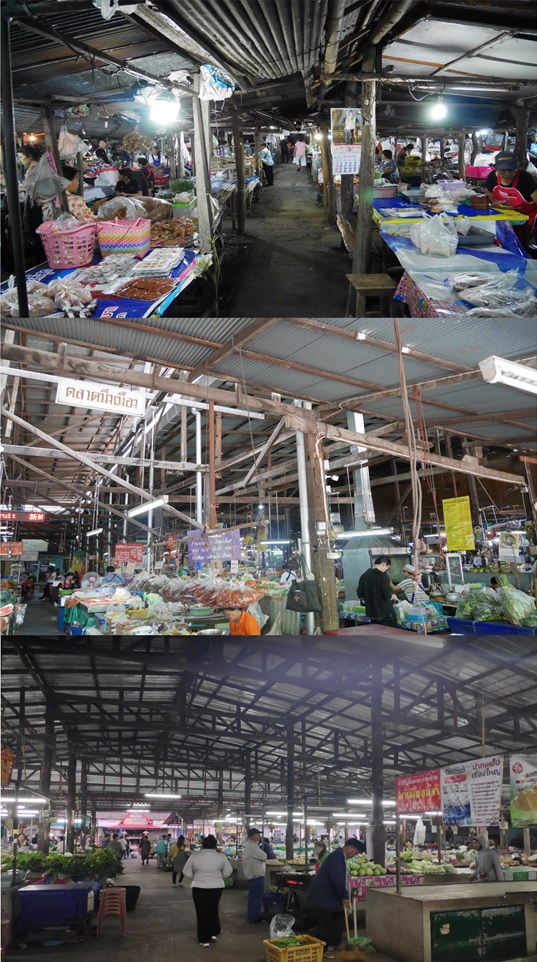ลักษณะทางกายภาพของกาดพื้นถิ่นในจังหวัดเชียงใหม่
Main Article Content
บทคัดย่อ
“กาด” เป็นภาษาพื้นถิ่นของประเทศไทยทางภาคเหนือ แปลว่า ตลาด ในอดีต กาดเป็นแหล่งศูนย์กลางของการแลกเปลี่ยนสินค้าอุปโภคบริโภคของคนในชุมชนและต่างถิ่น เป็นศูนย์กลางของการพบปะ เพื่อแลกเปลี่ยนการรับส่งข้อมูลข่าวสารกันภายในชุมชน และเป็นศูนย์กลางของการเรียนรู้วัฒนธรรมในท้องถิ่นของชุมชนนั้นๆ บทความนี้มีวัตถุประสงค์เพื่อศึกษาลักษณะทางกายภาพของกาดพื้นถิ่นในจังหวัดเชียงใหม่ และการดำรงอยู่ภายใต้พลวัตด้านสังคม และวัฒนธรรมในชุมชน เพื่อเข้าใจการดำรงอยู่ของลักษณะทางกายภาพทางสถาปัตยกรรมจากอดีตจนถึงปัจจุบัน วิธีการศึกษาใช้วิธีการวิจัยเชิงคุณภาพ ด้วยการสำรวจรังวัด เขียนแบบสถาปัตยกรรม การสังเกตการณ์อย่างมีส่วนร่วม และการสัมภาษณ์เชิงลึก โดยกาดที่ผ่านเกณฑ์การคัดเลือกมีอายุลักษณะทางสถาปัตยกรรมและอยู่บนเส้นทางการค้าในมีทั้งหมด 3 กาด ได้แก่ กาดแม่โป่ง กาดมิ่งเมือง และกาดทุ่งเสี้ยว
ผลการศึกษาลักษณะทางกายภาพ พบว่าตำแหน่งที่ตั้งอยู่บริเวณกลางชุมชนเป็นหลัก การจัดผังพื้นที่ค้าขายภายในกาด ประกอบด้วย อาคารขนาดใหญ่ ที่มีร้านค้าย่อยตั้งแผงอยู่ภายในเป็นอาคารหลัก มีผังการใช้งานภายในอาคารของกาด แบ่งออกเป็นช่องทางเดิน เรียงเป็นแถวแนวยาวในรูปแบบเส้นตาราง เป็นระเบียบและง่ายต่อการแบ่งเช่าและทำความสะอาด มีร้านค้าแผงลอย เรียงเป็นแถวบริเวณด้านหน้า หรือหลังตลาด พื้นที่ค้าขายของแผงวางสินค้าขึ้นอยู่กับการแสดงสินค้าแต่ละประเภท พฤติกรรมการค้า และการเลือกสินค้าของลูกค้า แบ่งออกเป็นการวางสินค้าเต็มหน้าร้านให้ได้มากที่สุด เช่น ร้านอาหารสด อาหารแห้ง และการแบ่งพื้นที่วางสินค้าเพื่อให้ลูกค้าสามารถเข้าไปเลือกสินค้าหรือเข้าไปนั่งรับประทานอาหารได้ เช่น ร้านขายเสื้อผ้า ร้านอาหารพื้นเมือง และยังการจัดผังในรูปแบบที่ต่างกันไป เช่น ผังรูปตัวยู ตัวแอล เรียงแถวเดียว รูปแบบอาคารโครงสร้างและวัสดุของกาดพื้นถิ่น สามารถแบ่งออกเป็น โครงสร้างไม้เนื้อแข็ง หลังคาทรงจั่วคลุมพื้นที่ขนาดใหญ่ และอาคารเพิงขนาดเล็ก ที่ใช้วัสดุที่หาง่ายในท้องถิ่น เช่น ไม้ ไม้ไผ่ ใบตองตึง สำหรับวัสดุที่ ในชุมชนเมืองมักเลือกใช้วัสดุที่มีความแข็งแรงและทันสมัยกว่า เช่นหลังคาเมทัลชีท เสาเหล็ก แผงวางสินค้าก่อคอนกรีต
ปัจจัยของการดำรงอยู่คือมิติความสัมพันธ์ทางสังคมและวัฒนธรรมของชุมชน ที่สร้างบรรยากาศความเป็นท้องถิ่น ได้แก่ วัฒนธรรมการค้าขายสืบทอดแบบรุ่นสู่รุ่น ภาษาพื้นถิ่นหรือภาษาเมืองที่ยังคงใช้กันสื่อสาร พฤติกรรมการอยู่ร่วมกันดั่งญาติมิตร ทั้งผู้ซื้อ ผู้ขาย และเจ้าของกาด ซึ่งก่อให้เกิดความผูกพันในการใช้พื้นที่กาดร่วมกันในมิติที่ต่างกันไป ทำให้ลักษณะของกาดพื้นถิ่นเชียงใหม่สามารถดำรงอยู่ภายใต้พลวัตที่เปลี่ยนแปลงไป และสามารถเป็นแนวทางในการอนุรักษ์ สืบสานให้กาดพื้นถิ่นดำรงอยู่ได้
Article Details
เอกสารอ้างอิง
Chuchat, C. (2002). Phokha wua tang: phu bukboek karn khakhai nai muban phak nuea khong prathet Thai (pho so 2398-2503). (In Thai) [Travelling (pack - ox) merchants: the beginning of village trading in Northern Thailand (B.E.2398-2503)]. (Research report). Chiang Mai: Sangsilp Printing Chiang Mai.
Oliver, P. (1997). Encyclopedia of vernacular architecture of the world. Cambridge : Cambridge University Press.
Oranratmanee, R. (2009). Sathapattayakam phuen thin karn sueksa wijai lae karn patibat wichachip sathapattayakam. (In Thai) [Vernacular architecture: architectural education, research and practice]. Journal of the Faculty of Architecture King Mongkut’s Institute of Technology Ladkrabang. 8 (1), 56-66.
Ounchanum, P. (2009). Karn songsoem atta lak phuen thin khong kat wua khwai Tungfabod Chiang Mai phuea karn thongthiao chumchon. (In Thai) [Promoting vernacular identity of Tungfabod kettle market Chiang Mai for community tourism]. (Master’s thesis). Chiang Mai: Chiang Mai University.
Panin, O. (1983). Talat phuenban Lan Na Thai. (In Thai) [Thai Lanna local market]. NAJUA: Architecture, Design and Built Environment, 3, 231-246.
Ruangsri, W. (2014). Kharawan lae phokha tang klai: karn ko kerd rat samai mai nai phak nuea khohg Thai lae dindaen ton nai khong Asia tawan oak chiang tai. (In Thai) [Caravan and chapman: modern state colonization in north of Thailand and Southeast Asia]. Chiang Mai: Centre for ASEAN studies Chiang Mai University.


